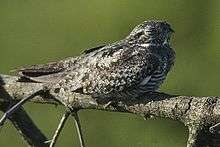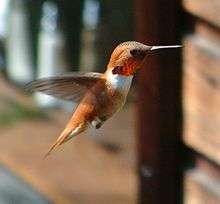Strisores
Strisores (/straɪˈsoʊriːz/ stry-SOH-reez[1])is a clade of birds. It includes the living families and orders Caprimulgidae (nightjars, nighthawks and allies), Nyctibiidae (potoos), Steatornithidae (oilbirds), Podargidae (frogmouths), Apodiformes (swifts and hummingbirds), as well as the Aegotheliformes (owlet-nightjars) whose distinctness was only recently realized. The Apodiformes (which include the "Trochiliformes" of the Sibley-Ahlquist taxonomy) and the Aegotheliformes form the Daedalornithes.[2]
| Strisores | |
|---|---|
 | |
| Common nighthawk, Chordeiles minor (Caprimulgidae) | |
 | |
| Male rufous hummingbird, Selasphorus rufus (Trochilidae) | |
| Scientific classification | |
| Kingdom: | Animalia |
| Phylum: | Chordata |
| Class: | Aves |
| Clade: | Neoaves |
| Clade: | Strisores Cabanis, 1847 |
| Orders | |
Description
The material evidence for this group is very equivocal; the most ancient Strisores are quite nondescript tree-dwellers but already tend towards peculiarly apomorphic feet, and no Cretaceous fossils are known. Torpor and other metabolic peculiarities are very frequently found in this group, perhaps more often than in any other bird lineage. The synapomorphies that define this clade are the ossa maxillaria separated by a large cleft, a mandible with very short pars symphysialis, and rami mandibulae very slender in their distal half.
Taxonomic history
The taxonomy of this group of birds has a long and complicated history. Jean Cabanis originally coined the name Strisores in 1847 as an order encompassing a much broader group of birds subdivided into two 'tribes': The Macrochires (hummingbirds, swifts, and nightjars, including oilbirds and potoos, but notably excluding frogmouths) and the Amphibolae (hoatzin, mousebirds, and turacos).[3] Hermann Burmeister later excluded the taxa in Cabanis' Amphibolae from Strisores, but added kingfishers and motmots.[4] Subsequent authors used either definition according to their own judgement, with Baird following Cabanis'[5], and Cooper following Burmeister's usage.[6] In 1867, Thomas Henry Huxley proposed the name Cypselomorphae for hummingbirds, swifts, and nightjars (including owlet-nightjars and potoos), however, he considered frogmouths and oilbirds unrelated due to aspects of their skull morphology.[7] In the 1880s Anton Reichenow continued to use Strisores in a similar sense as Huxley's Cypselomorphae (this time also excluding the owlet-nightjars)[8], but by the late 19th Century, Strisores had fallen into disuse[9], and this remained the case through the 20th Century[10][11][12][13].
By the early 21st century, analyses of anatomical morphology and molecular phylogenomics demonstrated that the order Caprimulgiformes as had been used for much of the 20th century (oilbirds, potoos, nightjars, frogmouths, and owlet-nightjars) is actually paraphyletic respective to Apodiformes (hummingbirds, swifts, and treeswifts), with apodiform birds nesting deeply within caprimulgiformes and a sister taxon to the owlet-nightjars[14][15]. The discovery has led to a challenge of reconciling a Linnean hierarchy with phylogenetic relationships while still maintaining nomenclatural stability, resulting in a complicated situation where some researchers currently use the resurrected name Strisores in a new sense[15][16], others expand the order Caprimulgiformes to include the 'traditional' apodiform families[17], whereas others[18] use the superordinal name Caprimulgimorphae Cracraft, 2013[19], raising the 'traditional' caprimulgiform families to the rank of order.
Proposed phylogenetic definitions of Strisores and Caprimulgimorphae treat Strisores as the crown group and Caprimulgimorphae as the total group.[20] This allows both names to be valid, with similar but not identical meanings.
Evolution

Strisores has a well-represented fossil record, with fossils of most major strisorean lineages known from the Paleogene.[20]
The relationships of the Early Eocene Parvicuculus and Procuculus from the southern North Sea basin are unresolved, but they bear some similarities to cypselomorphs.
The fossil evidence is quite consistent in this group. Over some 20 million years, throughout the Eocene, the present-day diversity (as well as some entirely extinct lineages) slowly unfolds. By mid-Oligocene, some 30 million years ago, the crown lineages are present and adapting to their present-day ecological niches.
By the distribution of fossils, the Paleogene radiation seems to have originated in Asia, which at that time became a highly fragmented landscape as the Himalayas lifted up and the Turgai Strait started to disappear.
Several fossil taxa are tentatively placed here as basal or incertae sedis
- Eocypselus (Late Paleocene or Early Eocene)
- Paraprefica (Early Eocene?)
- Archaeotrogonidae (Early Eocene of England ?- Late Eocene/Early Oligocene of France)
- Hassiavis (Middle Eocene of Messel, Germany) - Archaeotrogonidae?
- Protocypselomorphus (Middle Eocene of Messel, Germany)
Systematics
Strisores contains the extant families Aegothelidae, Apodidae, Caprimulgidae, Hemiprocnidae, Nyctibiidae, Podargidae, Steatornithidae, and Trochilidae. Apodidae and Hemiprocnidae are grouped together as Apodi, Apodi and Trochilidae are grouped together as Apodiformes, and Apodiformes and Aegothelidae are grouped together as Daedalornithes.
Cladogram based on Prum et al.[16], with phylogenetic definitions following Chen et al.[20]:
| Strisores |
| ||||||||||||||||||||||||||||||||||||||||||
Cladogram based on Reddy, S. et al. (2017)[17]:
| Caprimulgiformes |
| ||||||||||||||||||||||||||||||||||||||||||
| sensu lato |
References
- Whitney, William Dwight (1896), The Century Dictionary: An Encyclopedic Lexicon of the English Language, VII, New York: The Century Co., p. 5996
- Sangster, George (2005). "A name for the clade formed by owlet-nightjars, swifts and hummingbirds (Aves)". Zootaxa. 799 (1): 1–6. doi:10.11646/zootaxa.799.1.1.
- Cabanis, Jean (1847). "Ornithologische Notizen. II". Archiv für Naturgeschichte (in German). Berlin. 13 (1): 308–352.
- Burmeister, Jean (1856), Systematische Uebersicht der Thiere Brasiliens : welche während einer Reise durch die Provinzen von Rio de Janeiro und Minas geraës gesammlt oder beobachtet Wurden (in German), 2, Berlin: Georg Reimer, p. 311, doi:10.5962/bhl.title.13607
- Baird, Spencer F. (1858), General report on the zoology upon the zoology of the several Pacific railroad routes. Part II. Birds, Reports of explorations and surveys, to ascertain the most practicable and economical route for a railroad from the Mississippi River to the Pacific Ocean., IX, Washington, D.C.: A. O. P. Nicholson, p. 128
- Cooper, J. G. (1870), Ornithology Of California, 1, Cambridge: Welch, Bigelow, & Co., p. 336
- Huxley, Thomas H. (1867). "On the classification of birds; and on the taxonomic value of the modifications of certain of the cranial bones observable in that class". Proceedings of the Zoological Society of London. 1867: 415–472.
- Reichenow, Anton (1884), Die Vögel der zoologischen Gärten : Leitfaden zum Studium der Ornithologie mit besonderer Berücksichtigung der in Gefangenschaft gehaltenen Vögel (in German), 2, Leipzig: L. A. Kittler, p. 162, doi:10.5962/bhl.title.13560
- Sharpe, R. Bowdler (1891), A review of recent attempts to classify birds; an address delivered before the Second international ornithological congress on the 18th of May, 1891, London: Taylor & Francis, pp. 1–90, doi:10.5962/bhl.title.13335
- American Ornithologists' Union (1910), A Check-List of North American Birds (3rd ed.), New York: American Ornithologists' Union
- American Ornithologists' Union (1931), A Check-List of North American Birds (4th ed.), Lancaster, PA: Lancaster Press
- American Ornithologists' Union (1957), Check-List of North American Birds (5th ed.), Baltimore, MD: The Lord Baltimore Press
- American Ornithologists' Union (1983), Check-List of North American Birds (6th ed.), Lawrence, KS: Allen Press
- Hackett, Shannon J.; et al. (2008). "A phylogenomic study of birds reveals their evolutionary history". Science. 320 (5884): 1763–1768. Bibcode:2008Sci...320.1763H. doi:10.1126/science.1157704.
- Mayr, Gerald (2010). "Phylogenetic relationships of the paraphyletic ,caprimulgiform' birds (nightjars and allies)". Journal of Zoological Systematics and Evolutionary Research. 48 (2): 857–879. doi:10.1111/j.1439-0469.2009.00552.x.
- Prum, Richard O.; Berv, Jacob S.; Dornberg, Alex; Field, Daniel J.; Townsend, Jeffrey P.; Lemmon, Emily Moriarty; Lemmon, Alan R. (2015). "A comprehensive phylogeny of birds (Aves) using targeted next-generation DNA sequencing". Nature. 526 (7574): 569–573. Bibcode:2015Natur.526..569P. doi:10.1038/nature15697. PMID 26444237.
- Reddy, Sushma; et al. (2015). "Why do phylogenomic data sets yield conflicting trees? Data type influences the avian tree of life more than taxon sampling". Systematic Biology. 66 (5): 857–879. doi:10.1093/sysbio/syx041. PMID 28369655.
- Jarvis, Erich D.; et al. (2014). "Whole-genome analyses resolve early branches in the tree of life of modern birds". Science. 346 (6215): 1320–1331. Bibcode:2014Sci...346.1320J. doi:10.1126/science.1253451. PMC 4405904. PMID 25504713.
- Cracraft, Joel (2013), "Avian higher‐level relationships and classification: Nonpasseriforms", in Dickinson, Edward C.; Van Remsen, James, Jr. (eds.), Non-passerines, The Howard and Moore Complete Checklist of the Birds of the World, 1 (4th ed.), Eastbourne, UK: Aves Press, pp. xxi–xliii, ISBN 9780956861108
- Chen, Albert; White, Noor D.; Benson, Roger B. J.; Braun, Michael J.; Field, Daniel J. (2019). "Total-evidence framework reveals complex morphological evolution in nightbirds (Strisores)". Diversity. 11 (9): 143. doi:10.3390/d11090143.